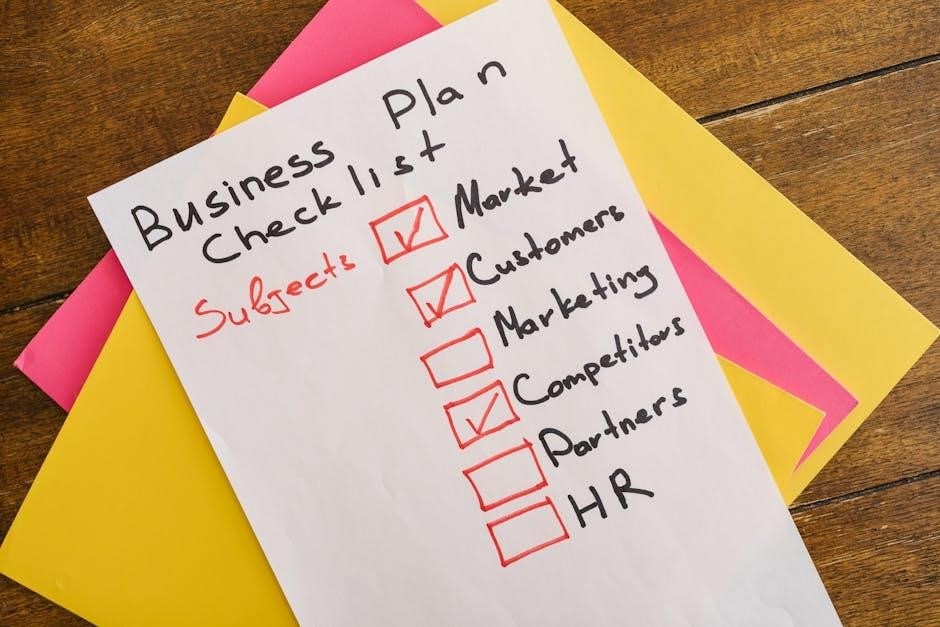HR roles and responsibilities are pivotal in managing an organization’s workforce, ensuring alignment with business goals, and fostering a productive work environment through strategic HR practices․
1․1 Definition and Evolution of HR Management
HR management involves managing an organization’s workforce to achieve business goals․ Evolving from administrative roles, modern HR focuses on strategic functions like workforce planning, diversity, and employee well-being․ Advances in technology and changing workplace dynamics have transformed HR into a critical enabler of organizational success and employee satisfaction․
1․2 Importance of HR in Organizational Success
HR plays a vital role in driving organizational success by aligning workforce capabilities with business objectives․ Effective HR practices enhance employee engagement, retention, and productivity, while ensuring compliance with labor laws․ Strategic HR initiatives foster innovation, improve workplace culture, and contribute to long-term sustainability, making HR a cornerstone of organizational growth and competitiveness․

Core HR Responsibilities
Core HR responsibilities include recruitment, employee relations, compensation, and benefits management, ensuring smooth organizational operations and maintaining a productive workforce aligned with company goals․
2․1 Recruitment and Hiring Process
The recruitment and hiring process involves identifying staffing needs, creating job descriptions, sourcing candidates, conducting interviews, and selecting the best fit for the role․ HR ensures compliance with labor laws and maintains fairness throughout the process to build a qualified and diverse workforce․
2․2 Employee Relations and Conflict Resolution
HR manages employee relations by fostering positive communication, addressing grievances, and resolving conflicts promptly․ They ensure a fair work environment, mediate disputes, and implement policies to maintain harmony and productivity, ensuring compliance with labor laws and promoting a culture of respect and collaboration within the organization․
2․3 Compensation and Benefits Management
HR oversees compensation and benefits, ensuring competitive pay structures and equitable rewards․ They design benefit programs, manage payroll, and ensure compliance with regulations․ This role attracts talent, retains employees, and aligns rewards with performance, fostering satisfaction and motivating employees to achieve organizational goals effectively․
Strategic HR Roles
Strategic HR roles involve aligning HR functions with organizational objectives, fostering growth, and enhancing performance through informed decision-making and innovative practices․
3․1 HR Planning and Workforce Management
HR planning ensures organizations have the right talent to meet business needs․ It involves analyzing workforce demands, recruiting, and developing employees to align with strategic goals, fostering productivity and growth․
3․2 Developing HR Policies and Strategies
Developing HR policies and strategies involves creating frameworks that guide employee management, ensuring compliance with laws, and promoting organizational culture․ These strategies align HR practices with business objectives, fostering a productive and compliant work environment while addressing employee needs and organizational goals effectively․
3․3 Aligning HR Goals with Organizational Objectives
Aligning HR goals with organizational objectives ensures that HR strategies support the company’s overall mission and vision․ This involves communicating effectively, coordinating efforts, and monitoring progress to achieve alignment, fostering a cohesive and goal-oriented work environment that drives organizational success and employee engagement․
Recruitment and Talent Acquisition
Recruitment and talent acquisition involve identifying, attracting, and hiring skilled candidates to meet organizational needs, ensuring a robust workforce that aligns with company goals and fosters long-term success․
4․1 Job Analysis and Job Description
Job analysis involves studying a role’s duties, responsibilities, and requirements to create detailed job descriptions․ These descriptions outline essential skills, qualifications, and expectations, enabling effective recruitment and ensuring candidates align with organizational needs, fostering clarity and precision in the hiring process to attract suitable talent efficiently․
4․2 Sourcing and Screening Candidates

Sourcing and screening candidates involve identifying and evaluating potential hires through strategies like job boards, social media, and referrals; HR reviews resumes, conducts interviews, and assesses qualifications to find the best fit, ensuring efficient and effective recruitment that aligns with organizational needs and fosters a skilled workforce․
4․3 Onboarding and Employee Integration
Onboarding and employee integration involve orienting new hires to the organization’s culture, policies, and roles․ HR ensures a smooth transition by providing necessary documentation, training, and introductions to teams․ Effective onboarding enhances job satisfaction, reduces turnover, and quickly integrates employees into the workforce, fostering productivity and alignment with organizational goals from the start․
Employee Engagement and Retention
Employee engagement and retention focus on fostering a positive workplace culture, recognizing contributions, and providing growth opportunities to ensure employees remain motivated, productive, and committed to organizational success․
5․1 Performance Management Systems

Performance management systems involve setting goals, monitoring progress, and evaluating employee performance to enhance productivity․ These systems use feedback, appraisals, and development plans to align individual achievements with organizational objectives, ensuring continuous improvement and fostering a culture of accountability and growth within the workplace․
5․2 Training and Development Programs
Training and development programs enhance employee skills, knowledge, and performance․ These initiatives include workshops, e-learning, and leadership development, fostering career growth and organizational success․ Effective programs align with business goals, improve productivity, and cultivate a competitive workforce, ensuring employees are equipped to meet current and future challenges․
5․3 Employee Recognition and Motivation
Employee recognition and motivation are critical for fostering engagement and productivity․ HR implements programs like awards, bonuses, and public acknowledgment to appreciate employees’ contributions․ These initiatives boost morale, encourage retention, and create a positive workplace culture, aligning individual efforts with organizational goals and enhancing overall job satisfaction․

Legal Compliance and Risk Management
Legal compliance and risk management are essential HR functions, ensuring adherence to labor laws, mitigating workplace risks, and safeguarding organizational integrity․
6․1 Understanding Labor Laws and Regulations
Understanding labor laws and regulations is crucial for HR professionals to ensure compliance, prevent legal disputes, and maintain a fair workplace․ This includes knowledge of wage laws, anti-discrimination policies, and health and safety standards, enabling HR to guide organizations in adhering to legal requirements and fostering a compliant work environment․
6․2 Managing Workplace Safety and Health
HR plays a key role in ensuring workplace safety and health by implementing policies, conducting training, and monitoring compliance with regulations․ This includes risk assessments, emergency preparedness, and promoting a culture of safety to protect employees and maintain a healthy work environment․
6․3 Handling Discrimination and Harassment Issues
HR is responsible for addressing discrimination and harassment by enforcing policies, investigating complaints, and providing training․ This ensures a fair and inclusive workplace, protects employee rights, and minimizes legal risks for the organization, fostering a respectful and professional environment for all employees․

Technology in HR Management
Technology enhances HR efficiency through HRIS, automation, and data analytics, enabling better decision-making, streamlined processes, and improved employee experiences in strategic HR management․
7․1 HR Information Systems (HRIS)
HRIS streamlines HR processes by automating tasks like payroll, attendance, and performance tracking․ It centralizes employee data, improves accuracy, and enhances decision-making through real-time analytics, ensuring efficient HR management and better employee engagement․
7․2 Automating HR Processes
Automating HR processes reduces administrative burdens, enhances efficiency, and minimizes errors․ Tools like AI-driven systems optimize recruitment, onboarding, and payroll, enabling HR teams to focus on strategic initiatives and improve employee experiences through streamlined workflows and data-driven insights․
7․3 Data Analytics for HR Decision-Making
Data analytics empowers HR to make informed decisions by analyzing trends in retention, performance, and compensation․ It helps predict workforce needs, optimize recruitment strategies, and monitor diversity metrics, enabling HR to align strategies with organizational goals and improve overall efficiency through data-driven insights․
Leadership Development
Leadership development involves identifying, nurturing, and training future leaders to ensure organizational continuity and growth, focusing on strategic vision and effective team management․
8․1 Identifying and Nurturing Future Leaders
HR plays a crucial role in identifying high-potential employees through assessments and performance reviews․ Nurturing involves tailored development plans, mentorship programs, and leadership training to equip future leaders with essential skills, ensuring organizational succession and long-term success․
8․2 Leadership Training and Coaching
HR implements leadership training programs to enhance managerial skills, fostering growth and adaptability․ Coaching sessions and workshops are conducted to strengthen decision-making, communication, and strategic thinking, ensuring leaders align with organizational goals and drive team performance effectively․
8․3 Succession Planning
HR plays a crucial role in succession planning by identifying and developing future leaders․ This involves creating career paths, training programs, and mentoring initiatives to ensure seamless transitions․ HR aligns succession strategies with organizational goals, minimizing leadership gaps and fostering continuity, which is essential for long-term business sustainability and reducing turnover risks․
Diversity, Equity, and Inclusion (DEI)
HR drives diversity, equity, and inclusion by fostering a culture where all employees thrive, contributing to innovation and organizational success․
9․1 Promoting Diversity in the Workplace
HR promotes diversity by implementing inclusive hiring practices, training programs, and policies that celebrate unique perspectives, ensuring a culture of belonging and equal opportunities for all employees․
9․2 Ensuring Equity in HR Practices
HR ensures equity by developing fair policies, transparent processes, and unbiased decision-making frameworks, promoting equal access to opportunities, resources, and advancements for all employees, regardless of background or identity․
9․3 Fostering an Inclusive Work Culture
HR fosters inclusivity by promoting diversity training, encouraging open dialogue, and implementing policies that respect all backgrounds․ Creating safe spaces for diverse perspectives ensures employees feel valued, enhancing collaboration and innovation across the organization․

Challenges in HR Management
HR faces challenges like managing workforce diversity, addressing high employee turnover, and navigating global HR issues, requiring strategic approaches to maintain organizational harmony and productivity effectively․
10․1 Managing Workforce Diversity
Managing workforce diversity involves fostering an inclusive culture, addressing biases, and ensuring equitable opportunities․ HR must implement policies that promote diversity, equity, and inclusion, creating an environment where all employees feel valued and empowered to contribute their unique perspectives and skills effectively, enhancing organizational innovation and success․
10․2 Addressing Employee Turnover
Addressing employee turnover requires HR to identify root causes, enhance retention strategies, and improve workplace culture․ HR must analyze exit data, implement feedback systems, and develop programs to boost engagement and satisfaction, ensuring alignment with organizational goals to reduce turnover and maintain a stable, motivated workforce․
10․3 Navigating Global HR Issues
Navigating global HR issues involves managing cultural differences, legal compliance, and diversity across regions․ HR must address language barriers, varying labor laws, and expatriate management․ Ensuring fair practices, fostering inclusivity, and leveraging technology to streamline global processes are critical for maintaining harmony and productivity in multinational organizations․

Future Trends in HR
Future HR trends include remote work adoption, AI integration, and a focus on employee well-being․ Technology and data-driven decisions will shape HR practices, enhancing efficiency and employee satisfaction․
11․1 The Rise of Remote Work
Remote work is transforming HR roles, emphasizing flexible policies, virtual recruitment, and digital employee engagement․ HR must adapt by implementing remote onboarding, managing virtual teams, and ensuring equitable benefits to maintain productivity and employee satisfaction in a hybrid work environment․
11․2 Artificial Intelligence in HR

AI is revolutionizing HR by automating tasks like recruitment, screening, and performance tracking․ It enhances decision-making through data analytics, improves candidate matching, and enables personalized employee experiences; AI-driven tools also streamline payroll and compliance, allowing HR to focus on strategic roles while ensuring ethical considerations are addressed in technology implementation․
11․3 Focus on Employee Well-being
Prioritizing employee well-being involves creating supportive workplace cultures, offering mental health resources, and promoting work-life balance․ HR now focuses on holistic health initiatives, stress management programs, and inclusive policies to enhance job satisfaction and retention, ensuring employees thrive both personally and professionally within the organization․
HR plays a vital role in shaping organizational success by fostering employee well-being, driving strategic initiatives, and ensuring alignment with business objectives, ultimately supporting sustainable growth and employee satisfaction․
12․1 Summary of HR Roles and Responsibilities
HR roles encompass recruitment, employee relations, compensation, and policy development, ensuring alignment with organizational goals․ Responsibilities include maintaining records, fostering a positive work environment, and supporting strategic initiatives, ultimately driving employee engagement, retention, and organizational success through effective people management and compliance with labor laws․
12․2 The Impact of Effective HR Management
Effective HR management enhances organizational productivity, fosters employee engagement, and ensures alignment with business goals․ It promotes a positive work environment, improves retention, and supports compliance with labor laws, ultimately driving organizational success through strategic people management and fostering a culture of continuous improvement․
